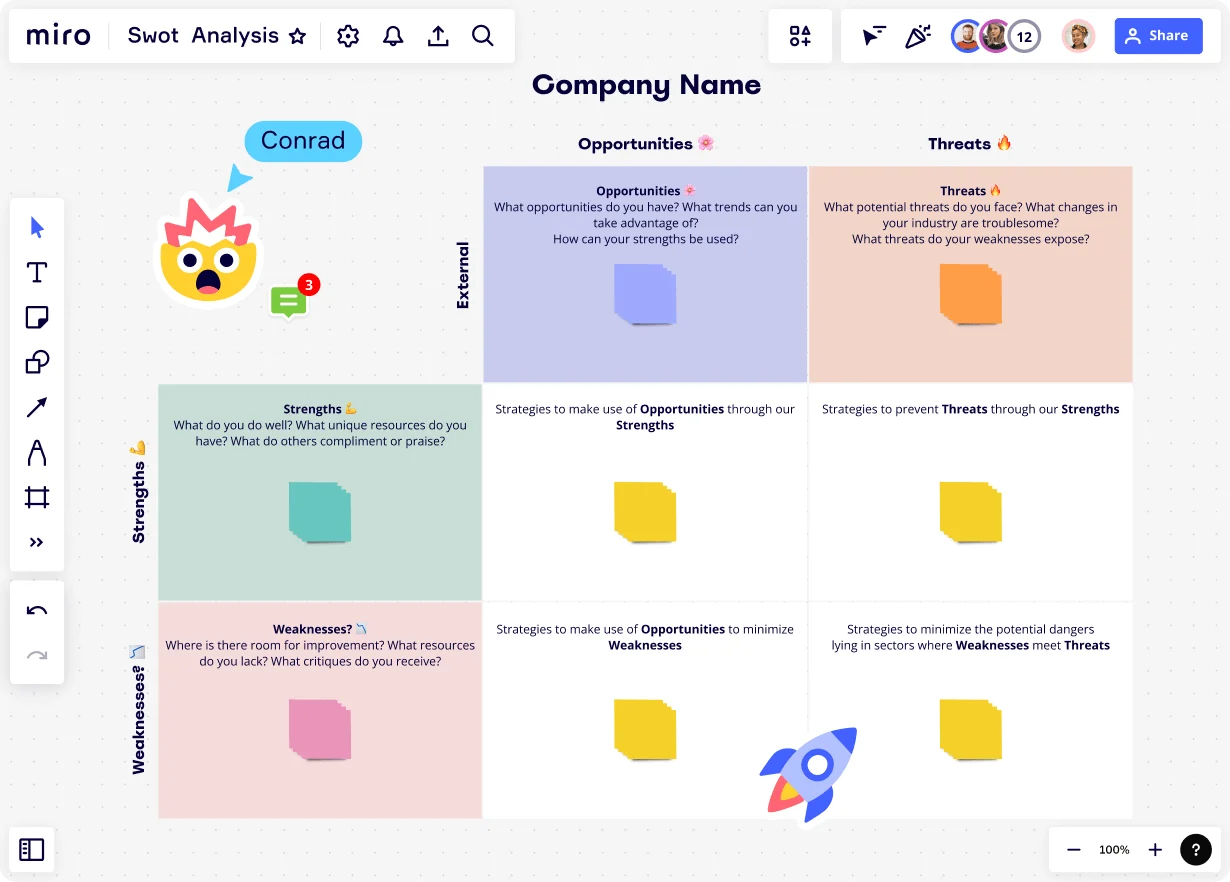
From SWOT to Strategic Mapping: Competitive analysis examples you can use now

Summary
In this guide, you will learn:
- How to use Miro’s competitive analysis templates to identify competitors and gather market data
- Various competitive analysis frameworks (VRIO, 3C, SWOT, Porter’s Five Forces, SOAR, Strategic Group Mapping) for competitive analysis
- Methods to evaluate competitors’ strengths, weaknesses, strategies, and market positioning
- How to customize templates and collaborate with teams
- Steps to collect competitor data from multiple sources
- Ways to visualize and communicate competitive insights for product development, marketing, and business strategies
Try Miro now
Join thousands of teams using Miro to do their best work yet.
Imagine playing chess without knowing your opponent's next move—or even their strategy. That's what running a business without competitive analysis feels like. It's not just about staying ahead; it's about understanding the board, spotting opportunities, and setting yourself up for success.
Whether you're launching a product, expanding into a new market, or just trying to outpace competitors, competitive analysis is the cornerstone of smart decision-making. Let's explore the frameworks and some examples of competitive analysis that can help you gain clarity and confidence in a crowded market.
Competitive analysis explained
What's a competitive analysis?
At its heart, a competitive analysis is a structured way of understanding your market and competitors. It helps you answer key questions like: Who are we up against? What are their strengths and weaknesses? How do we position ourselves to win?
Breaking it down further, the basic components of a competitive analysis include:
Competitor Identification: Begin by thoroughly analyzing the market to identify your competitors. Direct competitors are those companies offering similar products or services targeted at the same customer base. Indirect competitors, on the other hand, provide alternative solutions that meet the same customer needs. Conduct market research to compile a complete list of these competitors and assess their strengths, weaknesses, market positioning, and strategies. This will help you understand the competitive landscape and inform your own business strategies. Market positioning: Conduct a detailed analysis of the competitive landscape to understand where each competitor stands in terms of pricing strategies, targeted customer segments, and brand identity. This involves examining how competitors price their products and services, identifying their customer base's specific demographics and psychographics, and evaluating their branding approaches. By gaining insights into these areas, you can better determine your own competitive advantages and identify opportunities for differentiation in the market. Strengths and Weaknesses: Analyze the specific aspects in which competitors demonstrate exceptional performance, such as quality of products, customer service, or innovative marketing strategies. Also, assess the areas where they may struggle, including gaps in their offerings, pricing issues, or negative customer feedback. This thorough evaluation will provide valuable insights into both the competitive advantages and shortcomings within the market. Opportunities and Threats: Run a thorough analysis to identify specific gaps in the market that your business can use for growth and innovation. Additionally, evaluate potential external risks that may challenge your operations or success. This includes understanding competitive dynamics, shifting consumer preferences, and economic factors that could affect your strategy.
When you have this information at your fingertips, you're better equipped to make decisions that align with your goals and stand out in your industry.
When do you need a competitive analysis?
Competitive analysis isn't a "nice-to-have" step—it's a "must-have" tool in moments that define your strategy or product roadmap. Here's when it becomes crucial:
When you're building a product strategy
If you're launching a product, knowing the competitive landscape helps you define your unique value proposition. For example, understanding competitor features informs which capabilities you should prioritize—and which ones may not be worth replicating. Competitive insights also guide pricing decisions, positioning strategies, and feature differentiation.
When you're creating a marketing strategy
For marketing teams, competitive analysis provides a lens into how competitors communicate with their audience. By analyzing messaging, tone, and channels, you can spot gaps in the market and craft campaigns that stand apart.
When entering new markets
Expanding into a new market means facing a fresh set of players, cultural nuances, and customer expectations. Competitive analysis helps you identify potential barriers to entry and opportunities to localize effectively.
When reevaluating your business strategy
The market changes fast. If your business strategy is due for a refresh, competitive analysis ensures your moves are informed by current trends and competitive shifts.
In short, competitive analysis isn't just about keeping tabs on competitors; it's about enabling every team—whether product, marketing, or strategy—to make data-backed decisions.
Competitive analysis examples
Now that you know when and why competitive analysis matters, let's explore the tools and frameworks that make it actionable. Each of these approaches can shed light on different aspects of your competitive landscape.
Competitive analysis

This competitive analysis template focuses on collecting detailed information about your competitors, such as pricing, product offerings, customer reviews, and branding strategies. It's ideal for creating a baseline understanding of your market and identifying key players.
VRIO analysis
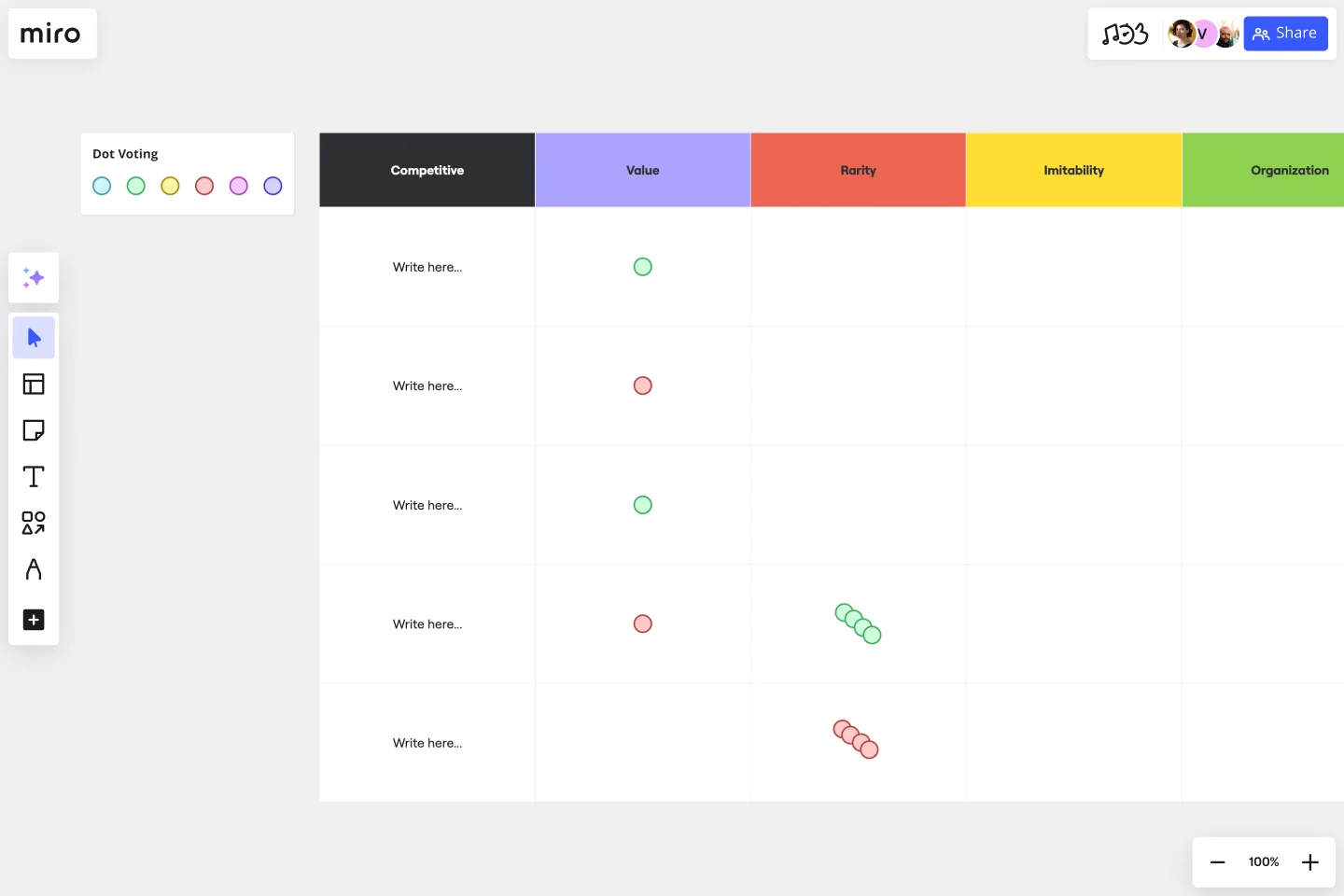
A VRIO template —Value, Rarity, Imitability, and Organization—helps you assess whether your internal resources can provide a sustainable competitive advantage. It's a go-to framework for understanding where your strengths lie and how they stack up against competitors.
3C Analysis
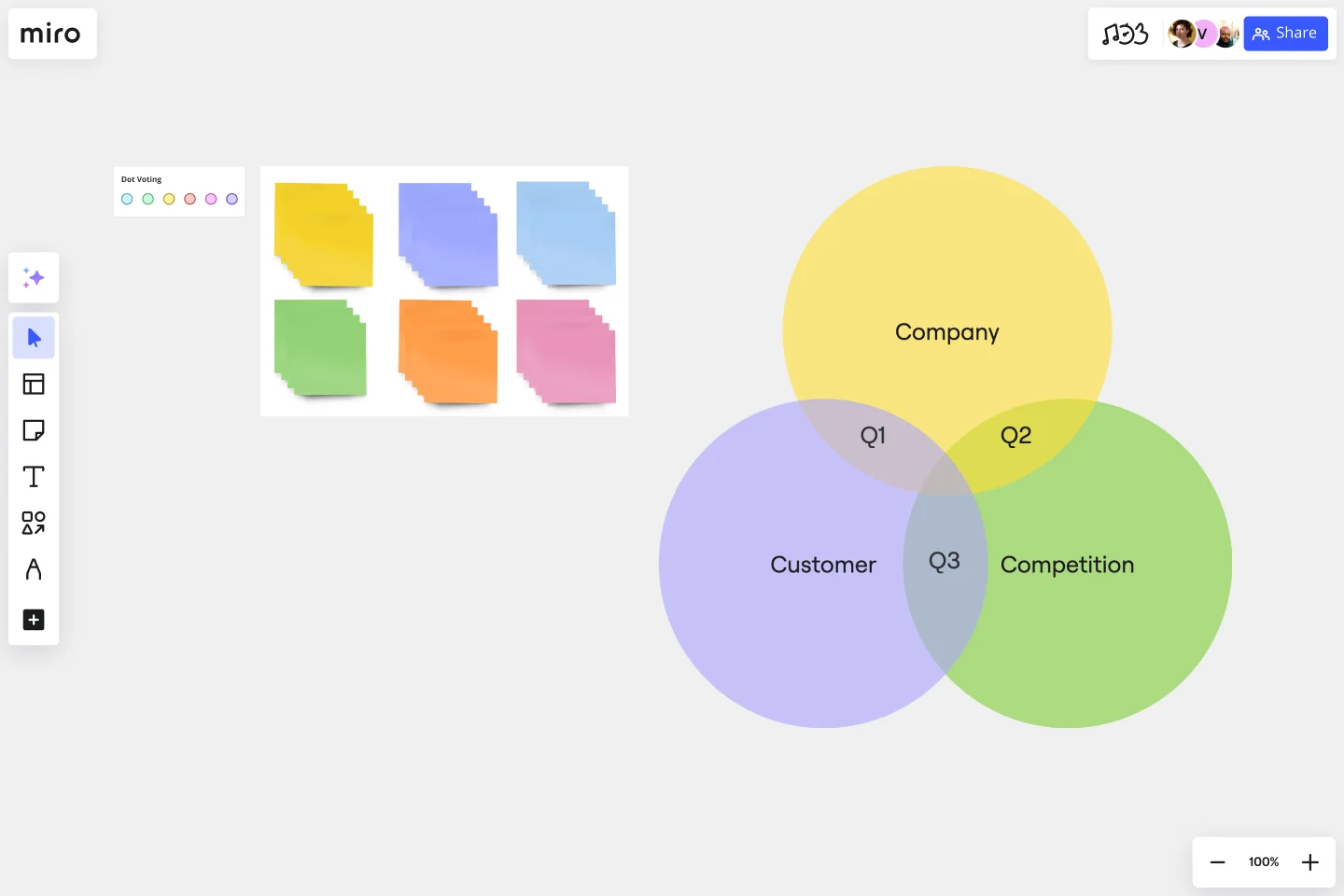
This 3C Analysis template looks at Customer, Company, and Competitor to uncover how your strengths meet customer needs better than competitors. It's especially useful for aligning business and marketing strategies.
SWOT analysis
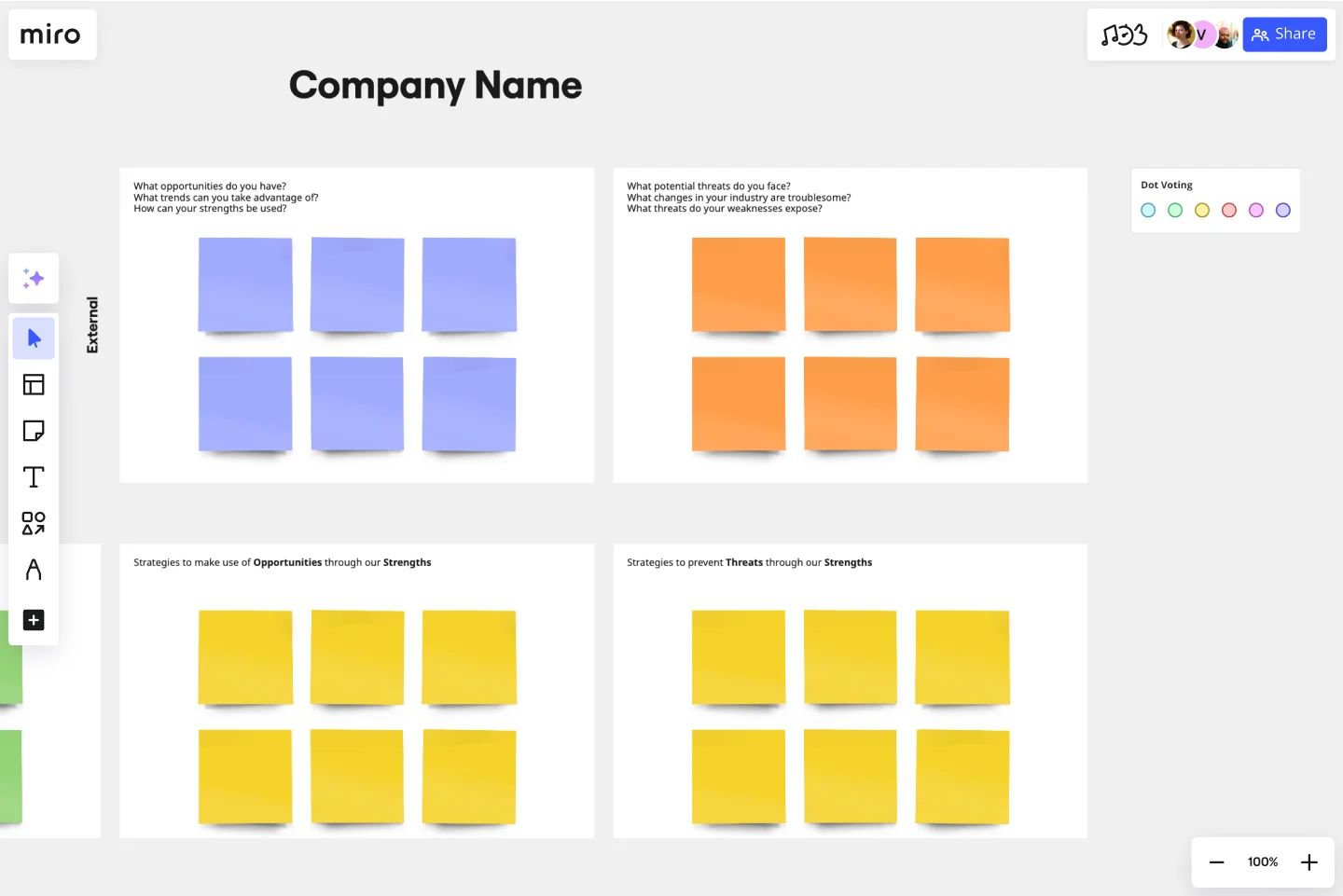
This classic framework—Strengths, Weaknesses, Opportunities, and Threats—is perfect for getting a snapshot of internal and external factors affecting your position. Simple but effective, a SWOT template remains a staple for identifying areas for growth and potential challenges.
Porter's 5 Forces
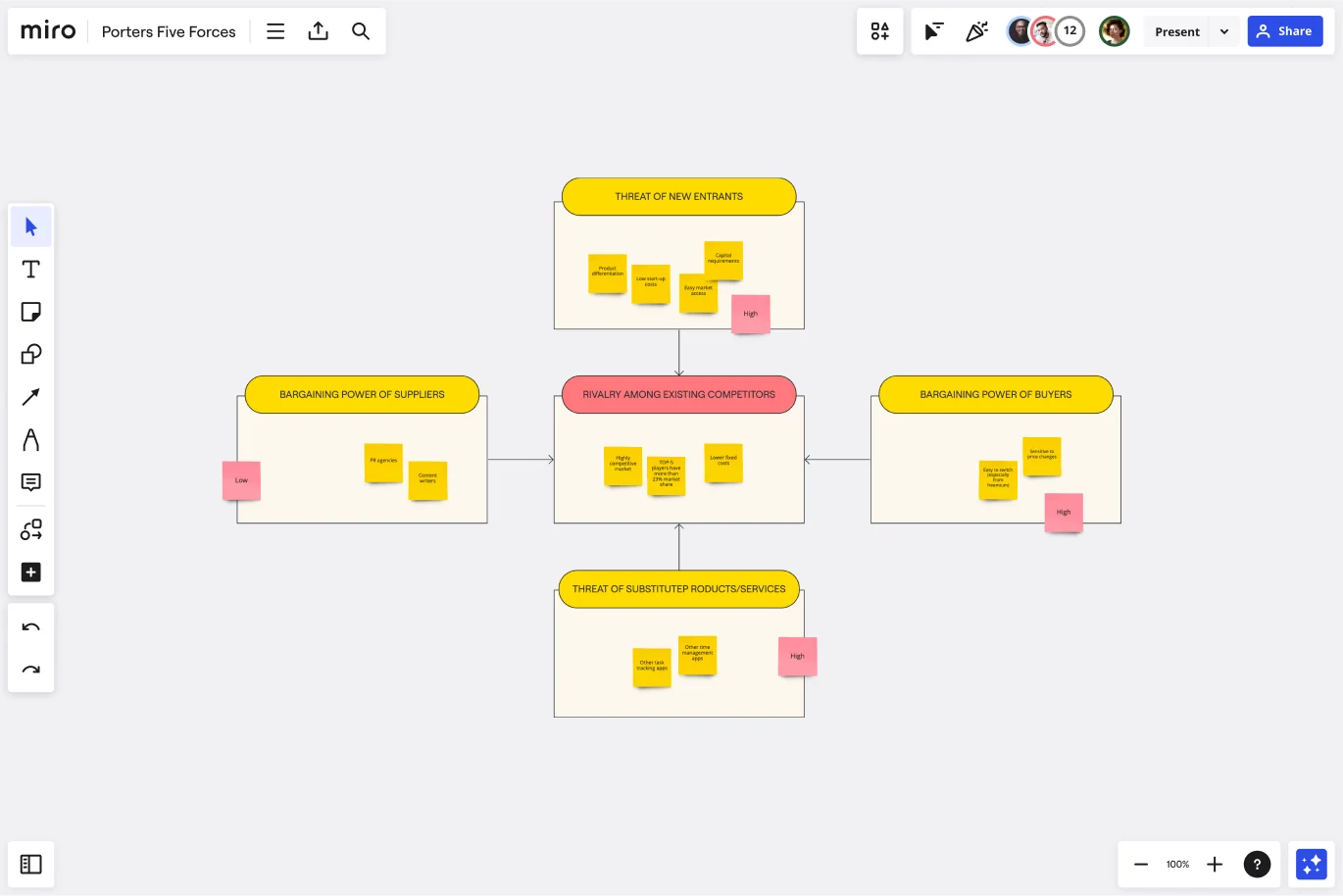
A Porter's 5 Forces template dives deep into the dynamics of your industry, analyzing competitive rivalry, the threat of new entrants, substitutes, and supplier/buyer power. It's ideal for understanding the pressures that shape your market environment.
SOAR analysis
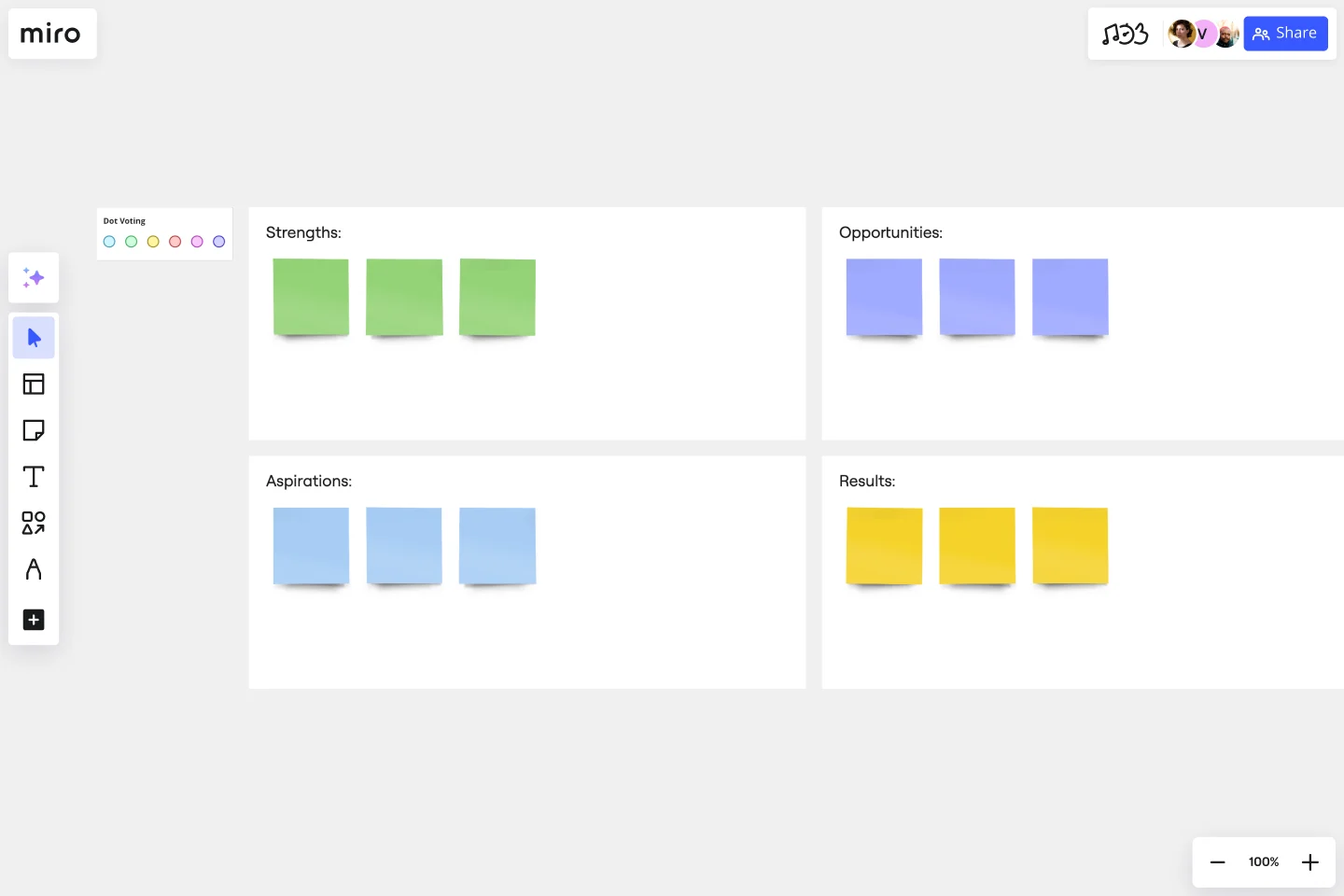
Focused on Strengths, Opportunities, Aspirations, and Results, the SOAR template encourages a positive approach, spotlighting areas of growth and inspiration. It's perfect for teams looking to leverage strengths and pursue big-picture goals.
Strategic Group Mapping
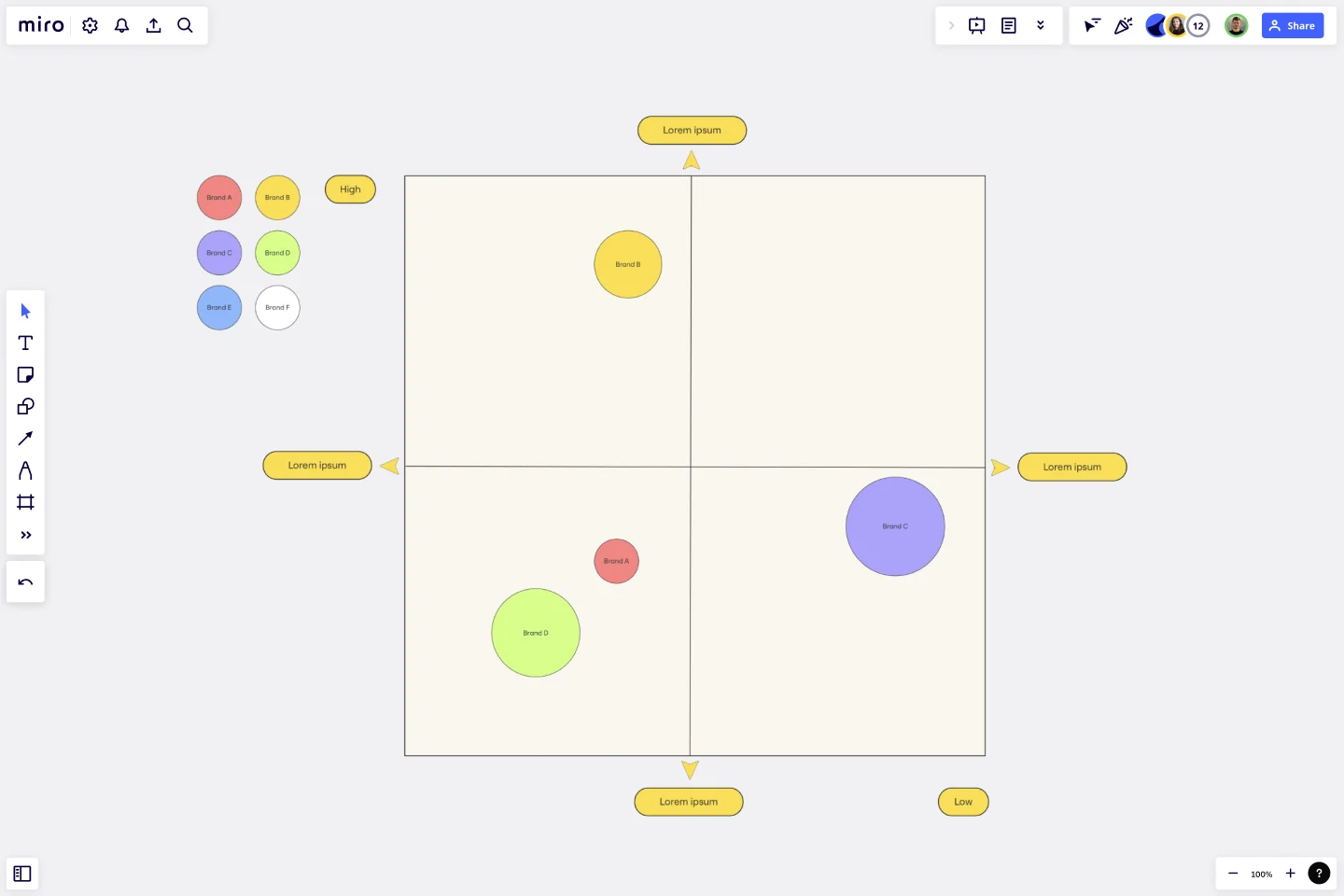
Visual and straightforward, the Strategic Group Mapping template helps you compare competitors across dimensions like price, quality, or customer focus. It's a great way to identify gaps in crowded markets and spot your opportunity to stand out.
Other competitive analysis examples from our community
Miro users bring their own creativity to competitive analysis. Here's how some of them do it:
Competitive analysis framework by Indra Kusuma
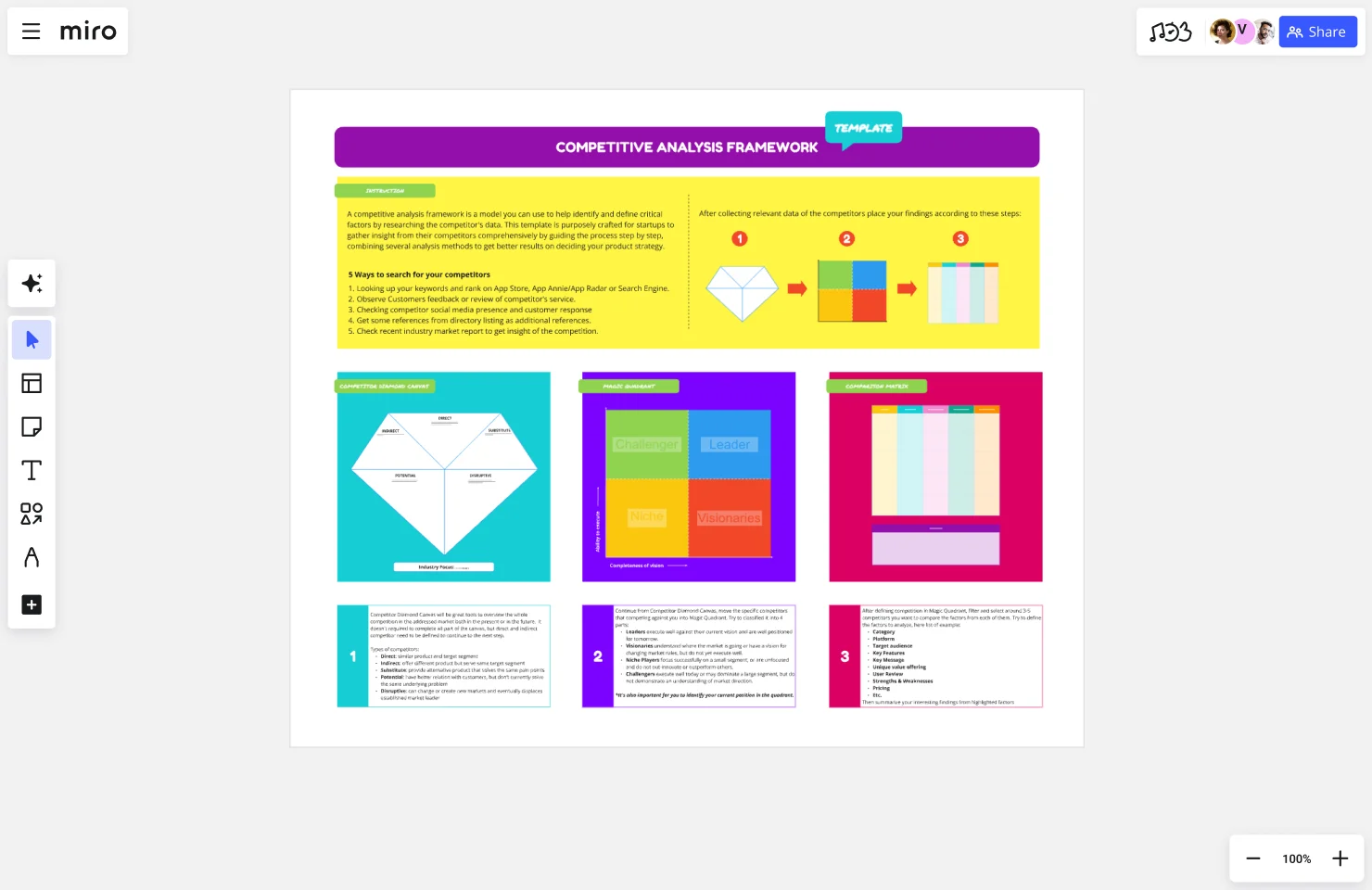
Indra Kusuma competitive analysis template champions a fast and focused approach, prioritizing insights that drive action. His method highlights competitor impact, which can help businesses assess how rivals might disrupt their strategies.
Competitive analysis by ServiceNow
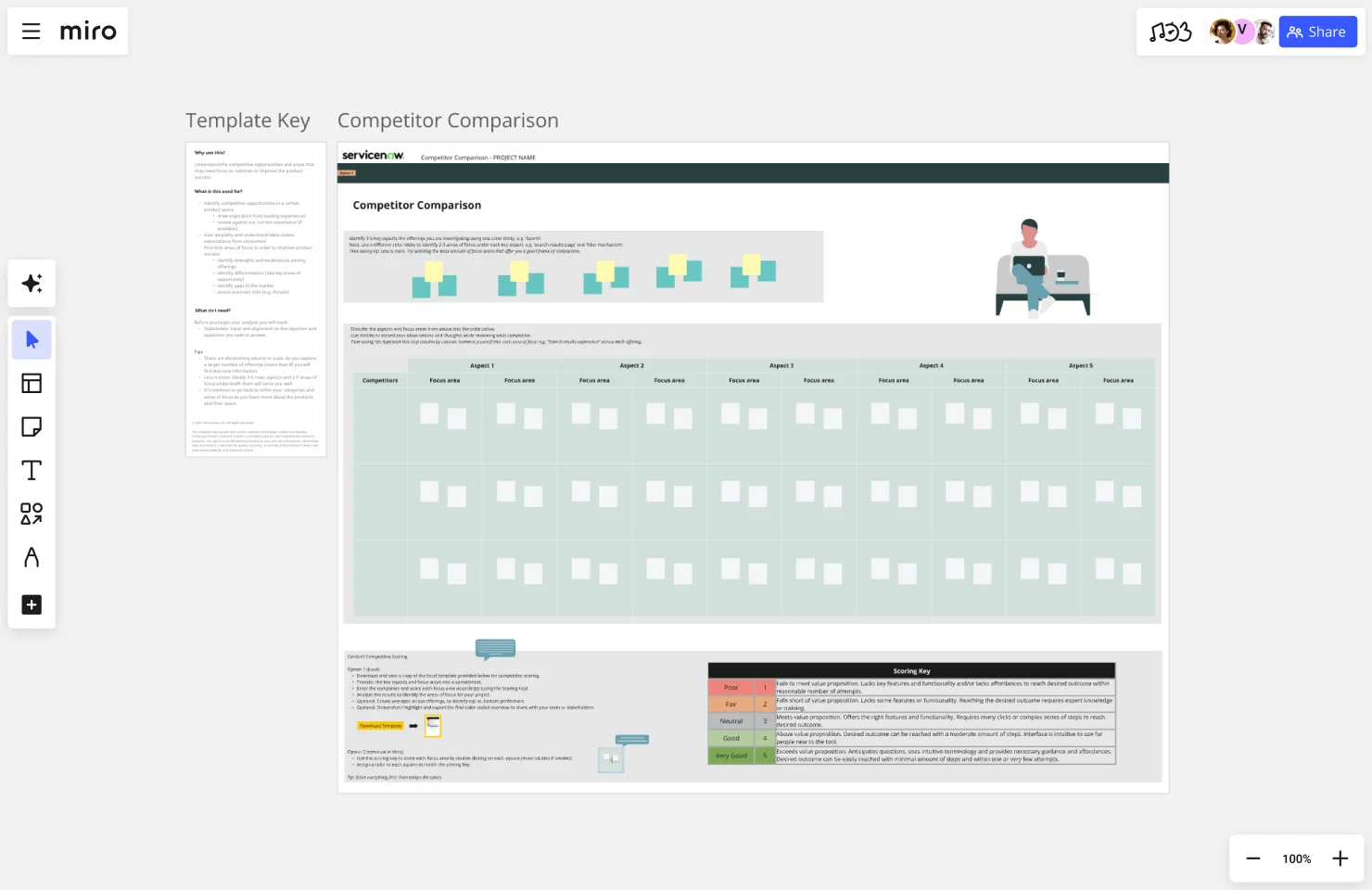
ServiceNow focuses on customer-centric competitive analysis template, mapping competitor features against direct customer needs. This method ensures that strategies stay relevant and actionable.
Competitive analysis by John Cutler
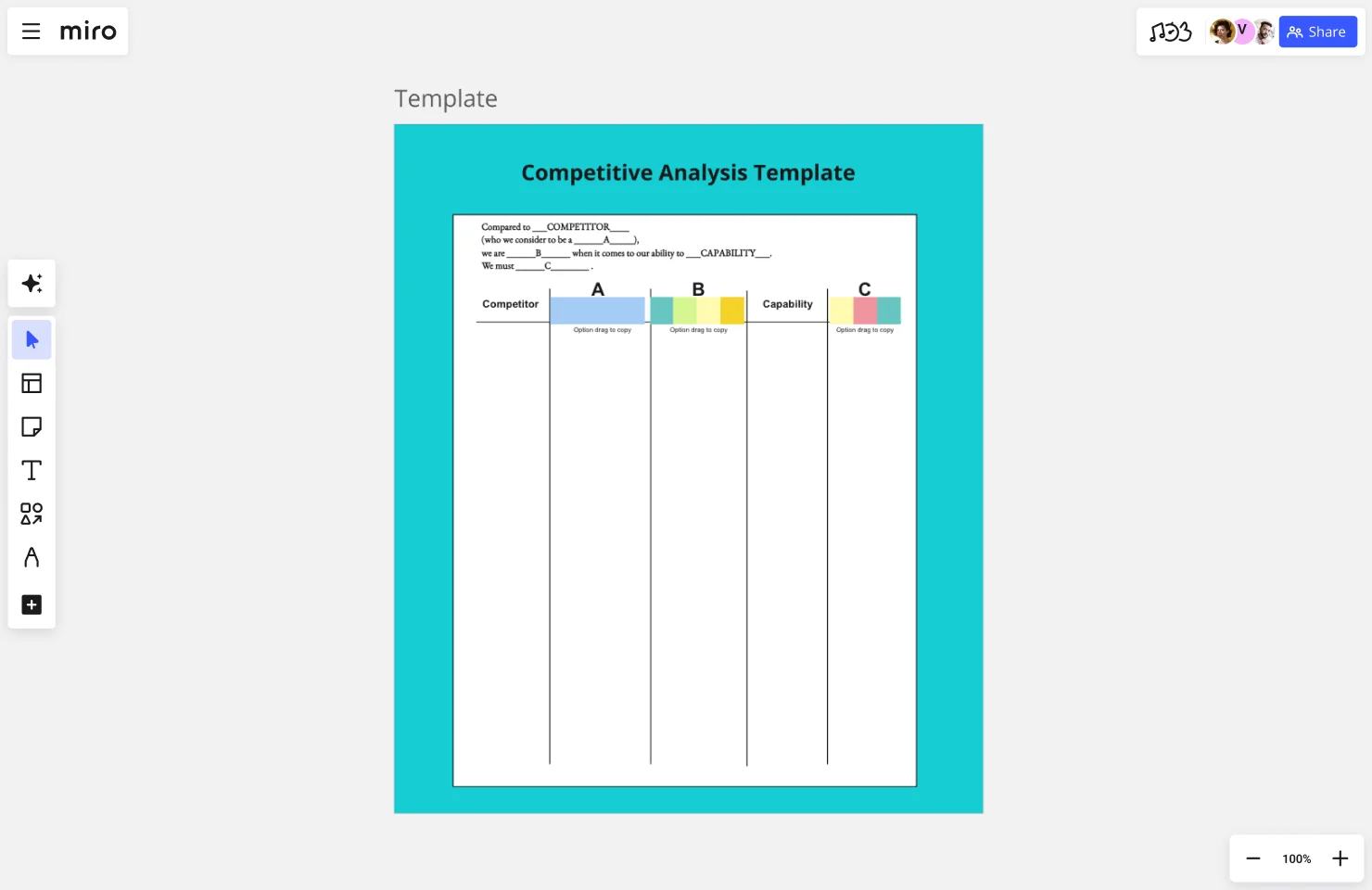
John Cutler's competitive analysis template emphasizes collaboration in competitive analysis. By involving cross-functional teams, he ensures alignment and keeps strategies flexible as the market evolves.
Tips on how to run your competitive analysis
Ready to dive in? Here are some tips to make your competitive analysis more effective:
1. Set a clear objective
Before gathering data, define what you're trying to achieve. Are you launching a product, entering a market, or refreshing your strategy? Knowing your goal ensures you focus on the right competitors and insights.
2. Choose the right framework
Not every framework fits every scenario. For example, use SWOT for high-level assessments, VRIO for internal resource evaluation, and Porter's 5 Forces for industry analysis. Pick tools that match your objectives.
3. Involve the right stakeholders
Collaborate with marketing, product, and strategy teams to get a well-rounded perspective. Different departments bring unique insights, making your analysis more comprehensive and actionable.
4. Use both qualitative and quantitative data
Numbers (like market share or revenue) are important, but qualitative data (like customer sentiment and branding strategies) provides context. Together, they paint a complete picture of the competitive landscape.
5. Revisit and refine
Markets change. Set a cadence for revisiting your analysis—whether quarterly or annually—to stay ahead of emerging trends and new competitors.
Strategize with confidence: how Miro helps businesses thrive
Competitive analysis isn't just about understanding your competitors—it's about setting your business up for success. By leveraging these frameworks, you can uncover opportunities, make data-driven decisions, and carve out your unique place in the market.
And with Miro's innovation workspace, competitive analysis becomes not only easier but also more collaborative. Use Miro's competitive analysis templates to start your analysis in minutes, or customize your own. Miro AI helps surface insights faster by organizing data and identifying patterns, while our visual tools make it easy to share findings across teams—whether you're brainstorming in real time or asynchronously.
With Miro, you're not just analyzing your competition; you're building strategies that help your business thrive. Ready to outsmart the competition? Start exploring what Miro can do today.
Author: Miro Team
Last update: October 22, 2025